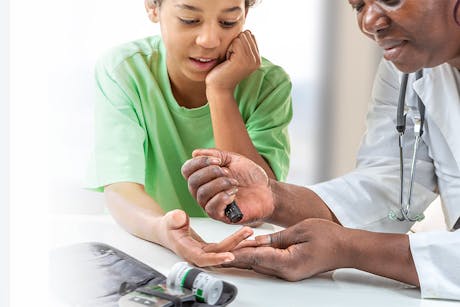Type 1 diabetes is usually diagnosed in children and young adults.
People with Type 1 diabetes — also known as juvenile diabetes — require insulin injections, because the body doesn’t produce its own insulin, or it produces too little.

What is Type 1 diabetes?
In Type 1 diabetes, the immune system mistakenly destroys the beta cells in the pancreas that make insulin. The body actually treats these cells as foreign invaders and attacks them. The destruction can occur over weeks, months, or years. When enough cells have been destroyed, the pancreas either stops making insulin or makes too little. Missing insulin must be replaced, or people with Type 1 diabetes can go into a coma and possibly die.
Symptoms of Type 1 diabetes:
- Frequent urination — Urinating frequently is the result of the body trying to flush out excess glucose in the blood.
- Blurred vision — Blurred vision occurs because of the buildup of fluid in the lens of the eyes, caused by high blood-glucose levels.
- Excessive thirst — This occurs as the body tries to flush out the higher sugar levels through more frequent urination, which can cause dehydration, making you thirsty.
- Frequent hunger — Feeling hungry all the time is the result of the cells of the body being starved for energy.
- Extreme fatigue — Diabetes reduces the body’s ability to convert the glucose in the blood into energy, causing a feeling of severe fatigue.
- Sudden changes in weight — If the body can’t properly burn blood glucose for fuel, it seeks other fuel sources, such as body fat or muscle. Insulin resistance can increase hunger, leading to weight gain.
- Nausea and vomiting — Nausea and vomiting are a result of the buildup of ketones in the blood.
Managing day-to-day life with Type 1 diabetes is important.
The plan for medically managing Type 1 diabetes is typically different for everyone. But maintaining insulin levels, developing healthy behaviors, and — particularly for children — having support when it’s needed away from home are all keys to success.
Medication to Treat Type 1 Diabetes
Unfortunately for people with Type 1 diabetes, there’s no such thing as an insulin pill that can be swallowed. Liquid insulin must be injected into the body using a syringe, an insulin pen, or an insulin pump. Less than 5% of Americans have Type 1 diabetes. And at this time, its exact cause remains unknown. It is not contagious, and it is not caused by eating sugar.
Diabetes Medical Management Plan
This form gives parents and caregivers of school-aged children with Type 1, Type 2, or another type of diabetes a way to notify school staff about the child’s condition, providing relevant information for easy access by the school nurse and other authorized personnel.
Helpful links
Healthy Lifestyle — Better Choices for Better Chances
Better choices lead to better chances of avoiding chronic diseases. Lifestyle behaviors can affect health. Making little, healthier choices can go a long way.
Learn moreHealthy Living
Live better. Our Healthy Lifestyle Map will show you where you can find fresh local produce at farmers’ markets and how to stay active at local fitness centers and parks.
View Healthy Lifestyle Map